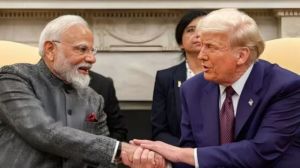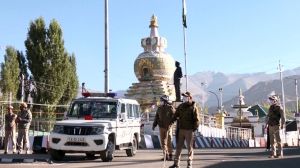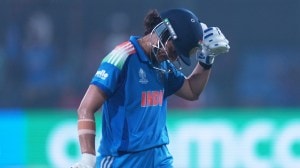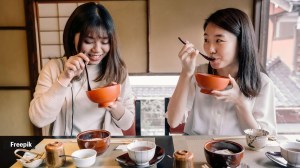Thinking Mans Artist
His works are shaped by wit and impulse and a refusal to take himself seriously. Shreyas Karle on why he wants to let his art remain fluid and illogical
In August last year,at a show at Project88 in Mumbai,visitors who walked into the gallery were greeted by near-empty walls. Tiny drawings and sketches hung forlornly,a few small installations stood in embarrassed loneliness in the corners. A makeshift room in the centre of the gallery housed a projector,a computer screen and a table fan,throwing up distorted shadows of visitors. In another room,a projector read,This projector does not work. The exhibition,Empty Studio and Other Works,was the result of a three-month residency in Zurich at the Rote Fabrik. The artist,Shreyas Karle,was trying to figure out why,increasingly,the global phenomenon of artists in residency was beginning to determine contemporary art language ― was the artist trying to integrate himself into the new environment,or was he merely interested in adding lustre to his profile? With the quirkiness that has come to signify his work,Karle produced an-almost-not-there series of work and threw the floor open to the viewers ― did they perceive the depth of an artists work by the volume he produced? Or did they find the emptiness full of potential,particularly when the artist himself seemed half-apologetic in setting them up?
This role of part-stimulator-part-manipulator plays out like an insider joke in most of the Mumbai-based artists work. I consider manipulation as the most important part of a creative persons thought process. Lack of manipulation is lack of imagination. One manipulates in order to stimulate the viewer as well as ones own senses. So the artist,his art and the viewer complete the manipulative circle while getting stimulated on unnecessary situations in life, says the 31-year-old. For the ongoing Kochi Muziris Biennale,he created a physical installation ― a fountain with a crack which made water flow downwards. For the installation Vastusanghralaya ki Dukan (Museum of Fetish Objects) that he showcased at the landmark exhibition Cinema City at the National Gallery of Modern Art in Mumbai last year,Karle zoomed in on tropes that recur in Bollywood films,ripping the stereotypes apart with wicked irreverence. A bottle of milk labelled Ma ka doodh,a brass pendent shaped like a temple tower,a church spire and a mosque dome (remember Amar Akbar Anthony?) among others,teased the viewer to take a second look and appreciate both the tribute to cinema and the critique of its banal clichés.
One of the reasons why Karle is fast emerging as an artist to look out for is this sociological perspective that he brings to his work and for his adaptability. He moves with ease between videos,sculptures,installations,illustrations,and drawings. I try to save myself from categorisation. I never wanted to be categorised,so I did everything. It is almost like trying to change the puzzle every time,so one cannot solve it. The fun is in the process of solving the puzzle rather than finding the solution. I am interested in the process,the way it behaves. For me,the idea of the work is more important,so based on that,I decide my medium. If I have to put the mediums in a kind of hierarchy,I would highlight the most basic visual element ― drawing, he says.
If his upcoming exhibition at the Vadehra Art Gallery,Delhi with wife Hemali Bhuta involves exploring the fluidity of the architectural notion of space through drawings,theres also the new interactive space Cona (Corner) that the couple and some of their friends have just initiated next to his studio in Borivali. The most important task for todays artist is to understand ones role,capability and limitations and how one can utilise these situations without selfish gains, he says. So at Cona,efforts are on to build a digital archive that can be accessed by all,including the local community. There is active involvement of visitor participants,who share data,footage,images,audio or other resources. Screenings and talks with established artists are on,and the space is also thrown open as a venue for residencies. The team also lets promising art college graduates,who have moved away from the field because of financial constraints,find their feet and possible gallery opportunities and/or sponsorships. Its difficult to be self-sustaining in art,so one needs facilitators and mediators to make the process smoother. Its something we have learnt from our own experience,so we want to address it, he says.
Karles own foray into art,however,was quite smooth. Growing up in a joint family in Mumbai,his middle-class parents were deeply supportive of his illogical experiments in art. An elder cousin was already in art school and Karle was enamoured by his different college life. Craving that lifestyle,he joined the LS Raheja School of Art in Bandra for a graduation course in fine arts. His father was his first admirer. He sometimes still feels I was better at landscaping, says Karle. He chipped away at a studio he rented close to his parents house for three years after graduating,before moving to Baroda for a Masters from MS University in Baroda. Baroda was just a wild card,completely unplanned. So I treated the next few years there like a boon,a second life. Baroda in a way was a catalyst to my dormant ideas, he says. A slew of awards later,Karle had his first hands-on experience of community projects at the Chintan Upadhyay-initiated Sandarbh Residency programme in Rajasthan,of which hes currently the director.
Impulse and wit are the twin stays of Karles art. Theres a sense of insouciance in his works,and a consistent refusal to take himself seriously. For instance,Karle ki Koshish: Jeevan ka Samanya Gyaan,his first solo show,was held simultaneously at two galleries in 2010,something that an artist rarely does. Both Pundole and Project88 approached me for a solo show on the same day. Rather than looking at it as a coincidence and making a choice,I decided to collaborate. Also,it was an interesting situation for me. Both spaces had identities of their own that I could make use of. The exhibition was an attempt to see what I am capable of doing. It showcased everything from drawings and videos to installations and site-specific works. The only thing I didnt do was a live performance, he says.
Yet,despite his constant need to test boundaries,both his own and the viewers,Karle shies away from deliberate titillation. Art has always been interactive subtly; there never was a need to deliberately make the viewer a part of it. I wouldnt blame any art practice that is interactive but I would not really appreciate a deliberately interactive situation, he says.
Summer 2013 will see him juggle a packed itinerary. Apart from the exhibition at Vadehra,hes working on a book of conversations with around 16 Indian contemporaries. Hes also been selected for the Gasworks residency in London in April.
While senior artist Atul Dodiya is appreciative of his potential,wife Hemali,another talented artist,says,I am a process-based artist,but Shreyas deals with the idea. We belong to the same school of thought and our togetherness has brought us to a stage where we could almost think for each other. But I must confess that Shreyas can still surprise me by his madness.
Karle is much less concerned about typecasting his art: I seldom try to define my practice; it makes me think about my art logically, he says.





- 01
- 02
- 03
- 04
- 05


























